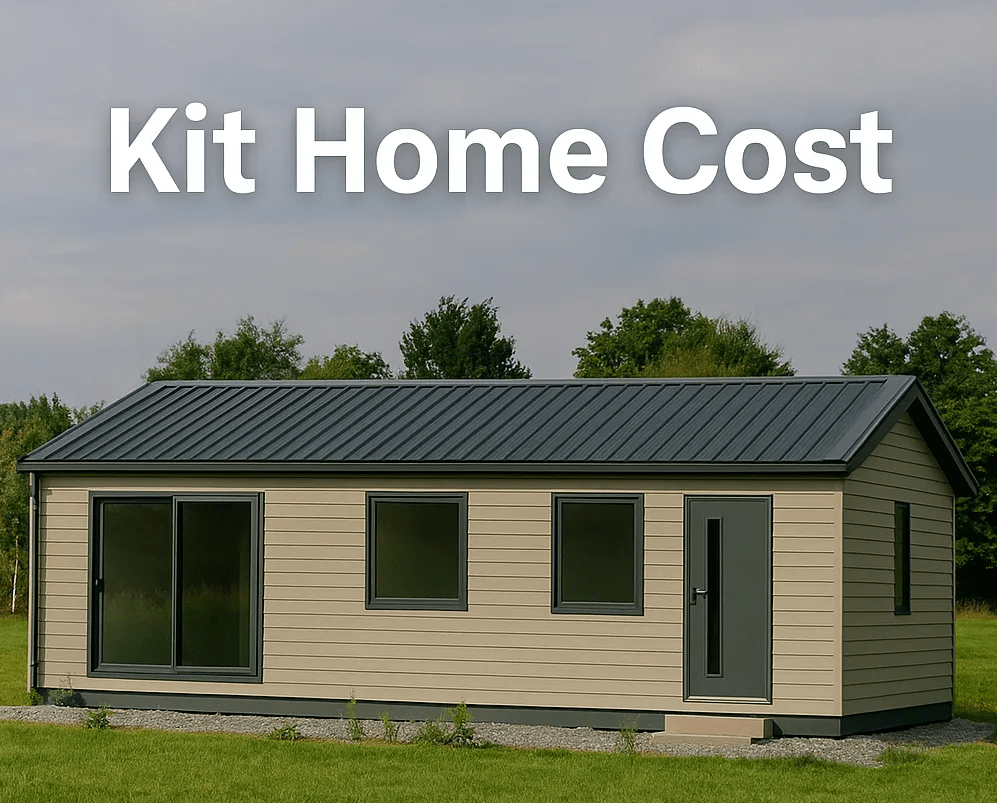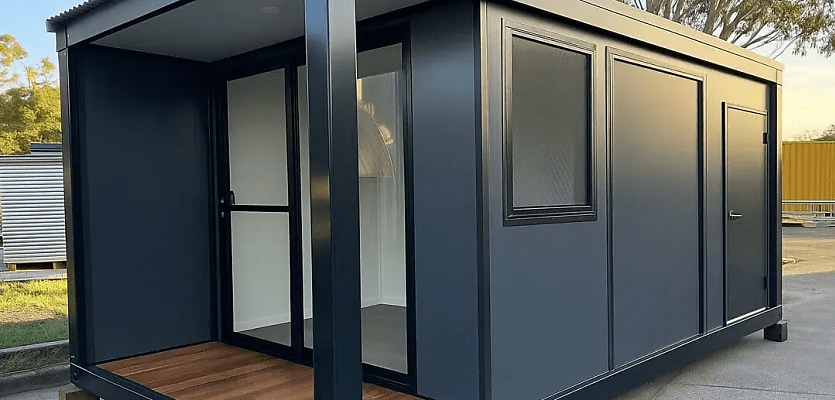You’ve probably noticed more buyers asking about smaller, faster, and more affordable ways to build. Whether it’s first-home buyers struggling with price rises or investors looking for smarter yields, kit homes are starting to show up in conversations where they never used to.
Key Highlights
- Kit homes are now a credible alternative to traditional housing, not a niche.
- Clear pricing and shorter build times are driving buyer interest.
- Agents who understand this sector can better support cost-conscious clients.
- Knowing reputable suppliers and build processes strengthens client trust.
- The kit home trend reflects a wider shift toward smarter, more flexible housing.
For years, they were seen as rural projects or temporary dwellings. Now, they’re architecturally designed, energy-efficient, and fully compliant — real homes that meet the expectations of modern buyers. What’s changed is both the quality and perception. The kit home market has quietly evolved into a serious player in Australian housing, and it’s beginning to reshape how buyers approach building.
As a real estate professional, understanding this shift is more than just an interesting background. It’s becoming essential. Kit homes are affecting everything from buyer demand to land use and long-term investment strategy. Knowing what drives this market — and how much it can influence property decisions — can help you guide clients with confidence in an increasingly cost-sensitive market.
The Rise of Kit Homes in Modern Property
The idea of a predesigned, factory-made home isn’t new, but what’s happening in the market today is very different from the old image of basic, prefabricated cabins. Modern kit homes are architecturally led, highly energy efficient, and engineered to meet the same building standards as traditional construction. They’ve evolved from being a budget workaround to becoming a serious option for home buyers who value transparency, sustainability, and speed.
This shift has been driven by a few big factors. Building costs have risen sharply, and skilled labour remains in short supply. Add long construction timelines and unpredictable material prices, and you have a climate where certainty matters more than ever. Kit homes offer that. They’re priced upfront, fabricated off-site, and can often be assembled in a fraction of the time of a standard build.
The growing interest isn’t limited to one group. First-home buyers see a way to enter the market sooner. Regional buyers are choosing them for flexible builds on larger blocks. Even investors are taking note, using kit systems for secondary dwellings and rental-ready projects.
For agents, this expansion means kit homes are no longer a niche curiosity. They represent a genuine shift in buyer behaviour — a reflection of a housing market that’s demanding smarter, faster, and more affordable solutions.
How Kit Homes Fit Into the Broader Housing Market
Kit homes have moved from the margins into the mainstream, reflecting the broader shift toward affordable and adaptable housing. Buyers today aren’t just looking for a place to live — they want flexibility, lower build times, and cost certainty. The new generation of kit homes offers exactly that, which is why they’re being discussed in the same breath as traditional new builds and turnkey developments.
Unlike the older “flat-pack” concepts, today’s kits are designed to blend comfort with compliance. They’re available in a wide range of layouts, from compact studios to full family homes, each one backed by site-specific engineering and high-quality materials. That mix of reliability and design appeal is reshaping how Australians view the idea of building from scratch.
One question agents hear often is how much does a kit home cost in Australia? While the answer depends on design, inclusions, and location, one of the biggest advantages of kit systems is pricing transparency. Buyers know what they’re getting and can plan around fixed material and labour costs — a welcome change in an industry often marked by budget blowouts.
To give you an idea of what your clients might expect, here’s a general breakdown of the typical cost components for a standard Australian kit home:
Typical Cost Breakdown for a Kit Home (Base-Level Example)
|
Component |
Approx. Cost Range (AUD) |
Notes |
|
Base Kit (Frame, Cladding, Roof) |
$40,000 – $80,000 |
Varies by size, design, and material choice |
|
Internal Fit-Out (Kitchen, Bathroom, Flooring) |
$30,000 – $70,000 |
Depends on level of finish |
|
Site Preparation & Foundation |
$10,000 – $25,000 |
Influenced by slope, soil, and access |
|
Council Fees & Certification |
$5,000 – $10,000 |
Includes engineering and permits |
|
Labour (Optional Trades Support) |
$15,000 – $30,000 |
Owner-builders can reduce this cost |
For agents, this level of transparency can help frame realistic discussions with clients. Rather than quoting vague estimates, you can explain what drives the final cost — and why pricing varies between base kits and fully finished builds.
This clarity builds trust, particularly among first-home buyers who are new to construction. It also helps manage expectations early in the buying or building process, reducing the risk of disappointment down the track.

Why Agents Should Pay Attention to the Kit Home Trend
For agents, the growth of the kit home market isn’t just a passing interest — it’s a sign of how quickly buyer priorities are changing. With housing affordability under pressure and demand for sustainable, low-maintenance properties on the rise, kit homes are quietly filling a gap in the market that traditional builds can’t always meet.
Buyers are increasingly drawn to solutions that balance quality with efficiency. Kit homes make that possible, giving people a path to ownership that doesn’t rely on long construction queues or unpredictable costs. For agents, understanding how these builds work — and who they appeal to — can make a real difference when guiding buyers through their options.
The segment is also expanding into new areas. Secondary dwellings and granny flats, often built using kit systems, are helping investors and families maximise property value without major renovations. For developers, kit home packages allow for small-scale housing projects that can be completed faster and sold more affordably.
From an agency standpoint, this creates a new layer of opportunity. Being able to explain the kit home process, outline timelines, and clarify inclusions helps build confidence with clients. It positions you not just as a sales professional, but as a trusted adviser who understands where the market is heading.
What to Look for in a Quality Kit Home Supplier
As kit homes become more popular, the range of suppliers entering the market has grown just as quickly. For real estate agents, understanding what separates a reliable provider from a risky one can make a big difference when helping clients make informed decisions.
The best suppliers approach kit homes as complete housing solutions, not just flat-packed frames. They provide full engineering certification, site-specific design, and detailed documentation that ensures compliance with Australian building codes. This level of preparation is what gives buyers confidence that their new home will meet council requirements and perform well over time.
Materials are another key factor. Reputable suppliers use proven, high-quality options such as BlueScope steel, known for its strength, durability, and resistance to corrosion. The inclusion of pre-drilled, precision-engineered components also simplifies assembly and reduces on-site error — something that matters for both owner-builders and investors.
It’s also important to look for warranties and after-sales support. Good suppliers back their products with long-term structural guarantees and provide guidance through the council approval and assembly process. For agents, knowing which brands offer these protections can help position certain properties as safer, higher-quality investments.
When clients ask how to identify a trustworthy kit home provider, being able to point to these standards shows you understand not just property — but construction quality too.
Market Comparison for Agents
To understand where kit homes fit into the broader property conversation, it helps to compare them directly with traditional builds. For agents, this isn’t just about price — it’s about timelines, buyer appeal, and how each option aligns with current market pressures.
While conventional builds still dominate urban developments, kit homes are starting to fill a growing space between full-scale construction and prefabrication. They offer a middle ground that combines design flexibility with predictable costs and faster delivery. In an environment where interest rates and material costs continue to fluctuate, that reliability is valuable.
Below is a quick reference comparison that can help during buyer discussions or client presentations.
Kit Homes vs Traditional Builds — What Agents Should Know
|
Feature |
Kit Homes |
Traditional Builds |
|
Average Cost Range |
Lower, with upfront pricing and package options |
Higher, often variable with materials and trades |
|
Build Time |
Typically 8–16 weeks after approvals |
6–12 months, depending on builder availability |
|
Design Flexibility |
Modular layouts and style choices within packages |
Fully customisable but slower and more expensive |
|
Engineering & Compliance |
Included in package with site-specific certification |
Managed through separate contractors or consultants |
|
Buyer Appeal |
Affordable, sustainable, and low-maintenance |
Suits buyers seeking prestige and complete customisation |
|
Resale Potential |
Increasing as awareness and quality improve |
Established, with predictable long-term value |
For real estate professionals, this table offers a snapshot of where the market is shifting. Kit homes may not replace conventional construction, but they’re establishing a clear role within it — particularly for buyers focused on efficiency, sustainability, and certainty.
When you can explain those differences clearly, you become part of the solution for clients trying to balance lifestyle goals with financial realities.
Opportunities for Real Estate Professionals
The growing popularity of kit homes isn’t just a construction trend — it’s a new area of opportunity for real estate professionals who understand where the market is heading. As affordability continues to challenge buyers across Australia, agents who can speak knowledgeably about alternative housing models will be better positioned to serve a broader range of clients.
For developers and landowners, kit homes offer a way to maximise the use of smaller or regional blocks without committing to large-scale projects. They can be marketed as modern, energy-efficient housing options with strong lifestyle appeal. For investors, they present opportunities in dual-occupancy builds, short-term accommodation, and relocatable dwellings that generate returns faster than traditional construction timelines allow.
Agents who take the time to learn the process — from approvals to assembly — can also support owner-builders looking to sell or lease finished projects. These clients often need guidance around valuation, resale potential, and marketing language that reflects the quality of a professionally engineered kit home.
The broader advantage is reputational. By demonstrating expertise in an emerging sector, you position yourself as a forward-thinking agent who understands the intersection of housing, design, and innovation. In a market defined by competition and evolving buyer expectations, that insight becomes a distinct point of difference.
Conclusion
The Australian housing market is changing quickly, and the rise of kit homes is a clear sign of that evolution. What started as a niche alternative has become a legitimate segment that combines affordability, sustainability, and speed — qualities that are increasingly important to today’s buyers.
For real estate agents, understanding the dynamics of this growing market isn’t about becoming a builder; it’s about staying informed. Knowing how kit homes are priced, what they offer, and which suppliers deliver quality gives you a practical edge when advising clients who are rethinking how they enter the property market.
As new housing models continue to emerge, the ability to speak confidently about options beyond traditional builds will become part of the skill set modern agents are expected to have. Kit homes represent more than a product — they represent a change in mindset. They’re proof that buyers want choice, speed, and control, and the professionals who can help them navigate that shift will be the ones who stay ahead.






You are not authorised to post comments.
Comments will undergo moderation before they get published.